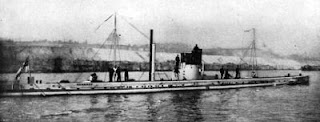Wednesday, July 20, 2011
NOAA targets "Graveyard of the Atlantic"
The “Graveyard of the Atlantic,” an area along the Outer Banks of North Carolina and the Virginia coastline, is the target of a new NOAA led expedition. Researchers will try to locate and study World War II shipwrecks sunk in 1942, including the German submarine U-576, off North Carolina during the Battle of the Atlantic, specifically the Battle of Convoy KS-520. The shipwrecks include sunken vessels from U.S. and British naval fleets, merchant ships and U-boats.
“This summer will be the most ambitious of our Battle of the Atlantic research expeditions, and potentially the most exciting,” said David W. Alberg, superintendent, USS Monitor National Marine Sanctuary. “This expedition is all about partnerships, collaboration and using cutting edge technology to search for and document historically significant shipwrecks tragically lost during World War II.”
On July 14, 1942, a merchant convoy of 19 ships and five military escorts left Hampton Roads, Virginia, sailing south to Key West, Florida, to deliver cargo to aid the war effort. The next day, off Cape Hatteras, North Carolina, Convoy KS-520 was attacked by German submarine U-576. The convoy fought back with an American warship ramming the U-boat while U.S. Navy aircraft dropped depth charges that sunk the submarine.
Alberg said NOAA’s expedition will build on work conducted by NOAA’s Office of National Marine Sanctuaries (ONMS) during the past three summers to document and preserve an important part of North Carolina’s history. The 2011 Battle of the Atlantic expedition survey will be conducted in four phases aboard the ONMS Research Vessel 8501.
Phase one of the project will include a wide area survey in water depths of 100 to 1,500 feet. Advanced remote sensing technologies, including an autonomous underwater vehicle (AUV) and multiple sonar systems, will be used to attempt to locate undiscovered wreck sites, including the U-576 and the Bluefields, a Nicaraguan tanker the U-576 sunk in a torpedo strike.
A more targeted survey will be conducted during the second phase, relying on an AUV and multibeam sonar systems to produce 3-D images of wreck sites. Scientists also will be investigating potential fuel leaks at the sites.
During phase three, researchers will return to selected targets identified in the wide area survey and use a 3-D scanner to create highly detailed models of the wrecks. In the final phase, a remotely operated vehicle (ROV) system and high definition 3-D video cameras will be used to create photo-mosaics of shipwreck sites for research, education and outreach purposes.
Many of the World War II wrecks off North Carolina, some lying as shallow as 100 feet (30 meters), serve as popular recreational dive sites and are visited by thousands of divers each year. Unfortunately, some of these wrecks have been severely damaged over the years by human activity. Both NOAA and the recreational diving community promote open access to the shipwrecks and encourage responsible dive behavior and preservation of underwater resources for future generations to enjoy.
At least 1,000 ships including the USS Monitor, a participant in the famous Battle of Hampton Roads during the American Civil War, have sunk in these waters since records began in 1526. The area is known for severe weather, strong currents, and navigational challenges, particularly in the Diamond Shoals area off Cape Hatteras where the warm waters of the Gulf Stream collide with the cold waters of the Labrador Current.
ONMS is leading the 2011 “Battle of the Atlantic” expedition survey with support and technical expertise from its Maritime Heritage Program, NOAA’s Office of Ocean Exploration and Research, NOAA’s National Centers for Coastal Ocean Science, the Bureau of Ocean Energy Management, Regulation, and Enforcement, and the National Park Service.
The picture shows U-9, an early Type IIB U-boat. Launched on July 30, 1935, the submarine did sink eight ships totaling 17,221 tons during 19 patrols. After being struck by a bomb from a soviet aircraft on August 20, 1944, U-9 went to the bottom of the Black Sea near Constanta.
Thanks to Global Adventures, LLC
Kathy Dowsett
www.kirkscubagear.com
Subscribe to:
Post Comments (Atom)

Every thing is fine. Now I just pray to God not to initiate the 3rd world war.
ReplyDelete